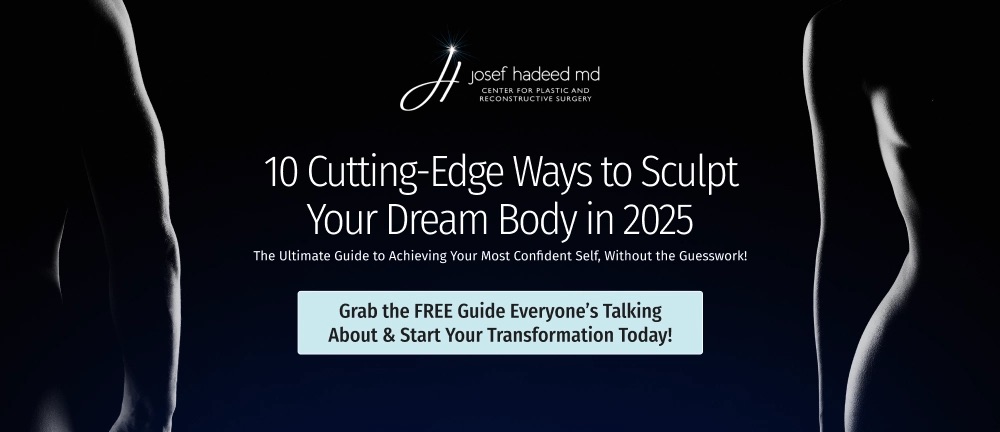How Painful Is a Tummy Tuck?
Posted July 30, 2025 in Body Procedures by Josef Hadeed, MD

Are you considering a tummy tuck but worried about the potential pain from this procedure? It’s an entirely understandable feeling and a common concern among potential tummy tuck patients. Deciding to undergo any surgery—especially an elective cosmetic surgery procedure—always comes with its fair share of worries, and pain is often at the top of that list.
In this blog, we’ll discuss what to expect regarding tummy tuck pain, including how to minimize discomfort and what to expect during the recovery process.
10 Min Read:
Table of Contents
- Is a Tummy Tuck Painful?
- Factors That Affect Pain and Recovery
- What to Expect From Different Types of Tummy Tuck Procedures
- Tummy Tuck Pain Recovery Timeline
- Tips For Minimizing Pain After Your Tummy Tuck
- When Pain Signals a Problem
- Ready to Transform Your Figure With a Tummy Tuck in Beverly Hills?
Is a Tummy Tuck Painful?
A tummy tuck (also known as abdominoplasty) is a popular cosmetic procedure that tightens the abdominal muscles and the abdominal wall and removes excess skin and fat, giving your midsection a smoother, firmer appearance. According to the American Society of Plastic Surgeons, over 171,000 tummy tuck procedures were performed in 2024. This body contouring procedure is often performed for cosmetic purposes to achieve a more toned abdominal region. A tummy tuck is considered a major surgery due to the extent of tissue manipulation and the recovery involved.
Although tummy tuck recovery includes some degree of pain, any discomfort is usually easily managed and is only temporary.
During Surgery
One of the most commonly asked questions is, “Is a tummy tuck painful?” The good news about pain during tummy tuck surgery is that there isn’t any! Tummy tucks are performed using general anesthesia, which means you’ll be fast asleep. You won’t experience pain during your tummy tuck procedure.
After Surgery
Once you wake up from anesthesia, it’s normal to start feeling some soreness and tightness in your abdomen. The lower abdomen is often the most affected area, especially after abdominal muscle repair. Tummy tuck pain can vary from mild to moderate pain, and in some cases, it can be more painful, depending on how extensive your tummy tuck surgery was. If your abdominal muscles were tightened, which is done during a full tummy tuck procedure, you might feel a sensation similar to doing too many sit-ups; however, it will be a bit more intense than that.
Many patients report the following:
- Burning or stinging around your incision
- Muscle tightness
- Occasional sharp or shooting pains as nerves begin to heal
- General soreness that radiates around your core
Patients report varying experiences, with the worst discomfort peaking within the first 3 to 5 days. After that, the pain typically starts to taper off, becoming more manageable with each passing day.
Factors That Affect Pain and Recovery
Pain is expected during tummy tuck recovery, but the intensity and duration vary from person to person. Many patients experience the most significant pain during the first week following the tummy tuck procedure, often rating it around a 6 or 7 out of 10. By the second week, pain levels typically decrease to a more manageable rating of 3 or 4.
Effective pain management following the procedure can significantly improve your comfort during recovery from surgery. Factors such as your age, overall health, body weight, and the specific type of tummy tuck procedure performed can all influence how you experience pain and how quickly you recover. Listening to your body and following your surgeon’s recommendations will help reduce pain and ensure a smoother recovery.
What to Expect From Different Types of Tummy Tuck Procedures
If you’re worried about how much pain you might feel after a tummy tuck—or how long you’ll be out of commission—it’s a good idea to talk with your surgeon about the different tummy tuck options. Not every tummy tuck is the same. Some tummy tuck options are less invasive and have a faster recovery, while others are more extensive and require a longer recovery process to heal.
- Mini Tummy Tuck: A mini tummy tuck, also known as a mini abdominoplasty, is an excellent option for individuals with a small amount of excess fat and extra skin in the lower abdomen below the belly button. This tummy tuck technique typically skips abdominal muscle repair and uses a smaller incision, resulting in less pain and a shorter recovery period. Many patients describe the discomfort as mild—more of a tight or sore feeling in the lower belly that improves pretty quickly. For many, over-the-counter (OTC) pain medicine is enough to stay comfortable.
- Full (Traditional) Tummy Tuck: A full or traditional tummy tuck removes excess fat and extra skin from the entire abdomen while also tightening the abdominal muscles. Since muscle repair is more invasive, recovery can be tougher, especially during the first few days. Patients often describe the pain as a deep, tight, pulling sensation in the core, especially when moving, coughing, or standing up straight. That said, the pain usually improves noticeably after the first week.
- Extended Tummy Tuck: Individuals who have undergone significant weight loss may be left with significant excess skin. An extended tummy tuck goes beyond the traditional tummy tuck technique by also addressing the flanks and sometimes the lower back. Because it covers a larger area and often requires longer incisions and more muscle repair, it can be more uncomfortable and take longer to heal. The soreness and tightness may last longer than with a mini or full tummy tuck, and you’ll likely need extra time to fully recover before going back to your usual routine.
- Skin Tightening With Renuvion®: As we age, our skin loses its elasticity, resulting in loose skin. To further enhance tummy tuck results, Dr. Hadeed may recommend pairing your procedure with Renuvion® skin tightening. This advanced technology uses a combination of radiofrequency (RF) energy and helium plasma to gently contract the tissues beneath the skin in the abdominal area, resulting in a firmer, more sculpted look. Renuvion® is especially helpful for treating areas with mild to moderate skin laxity, such as the flanks and upper abdomen. This treatment can be performed during or after your tummy tuck surgery. Most patients find that Renuvion® does not add significant discomfort or increase recovery time, and the improved definition and smoother contour make it well worth it.
Tummy Tuck Pain Recovery Timeline
Everyone’s tummy tuck recovery experience is slightly different. Here’s what you can expect in terms of pain and healing:
Days 1–3 (Immediate Post-Op)
The pain will be most noticeable during the first few days following your tummy tuck procedure. During this time, you’ll likely feel sore, swollen, and tender, especially when moving, standing up, or shifting positions. If you have abdominal muscle repair and accidentally engage your core while moving, your muscles will immediately let you know. Dr. Hadeed will provide prescription pain medications to help manage the discomfort, and you can also use OTC pain relievers. During these first few days, you’ll likely need help with basic activities, such as standing, walking, and using the bathroom. Assistance with household chores is also often necessary during this period.
Days 4–7
Most begin to experience less pain during this time, although you’ll still be sore. Many patients transition from prescription to only OTC pain relievers by the end of the week. Compared to other abdominal surgeries, such as a C-section or more extensive procedures, the pain level and recovery time can vary, with some tummy tuck surgeries resulting in more or less pain and different healing experiences. You’ll still need to walk in a slightly hunched position to avoid straining your incision. Swelling and feelings of tightness remain, but you’ll likely feel more mobile each day. It also helps to take several short, slow walks around your house each day to promote blood flow and speed up healing.
Week 2
Pain will continue to steadily improve, but you may still experience some pain when coughing, laughing, or standing up straight. You may be able to return to light desk work and household activities around this time, depending on how you feel. As you resume these activities, it is important to continue to manage pain effectively to support your recovery. Listen to your body, and don’t overdo it.
Weeks 3–6
By the end of the first month, you’ll feel significantly better. Discomfort will continue to subside, becoming similar to general muscle soreness or fatigue rather than sharp pain. You may begin light exercise (as long as Dr. Hadeed permits you), and your body will continue to heal internally. However, you should still avoid strenuous exercise until your surgeon clears you for these activities.
Week 7 and Beyond
At this point in your tummy tuck recovery, most of the pain has resolved, and you can usually return to your regular activities—even the more strenuous ones. However, internal healing can continue for up to three months or longer for full recovery. You may notice occasional twinges or sensitivity in the area around your incision or belly button. Numbness may persist for a few months, but it’s usually not painful.
It’s important to have realistic expectations about the timeline for full healing and the final appearance of your abdomen, as results and sensations can continue to change over time.
Tips For Minimizing Pain After Your Tummy Tuck
While some pain after a tummy tuck is unavoidable, there are definitely ways to reduce it and feel better more quickly.
- Follow Instructions Closely: Your surgeon will provide you with detailed postoperative instructions; it’s important to follow them closely. These instructions provide information on how to care for your wounds, when to resume activities, and guidelines for taking your pain medication. Following these instructions carefully can reduce pain, prevent complications, and promote faster healing.
- Stay Ahead of the Pain: Effective pain management following your tummy tuck surgery is important. Don’t wait until you’re in pain to take your medication. Take your pain medication as directed, even if you feel ok at the time. Letting the pain “catch up” can make it harder to get under control.
- Wear Your Compression Garments: Wearing your post-surgical compression garment as instructed not only helps minimize swelling but also supports your abdominal area, reducing movement-related pain and promoting better healing and optimal results.
- Walk Early and Often: You may not feel like moving much, especially during the first week after your tummy tuck, but gentle movement is an essential part of the healing process. Walking improves circulation, reduces swelling, and helps prevent blood clots. Taking short walks to the bathroom or around the room is helpful in the early stages, and you can gradually build up more endurance over time. However, following the procedure, you should avoid strenuous exercise, heavy lifting, or anything that strains your abdominal muscles until your surgeon clears you to perform these activities.
- Ask About Nerve Pain Relief: Some patients experience nerve-related pain after a tummy tuck procedure, which can feel like tingling, burning, or sensitivity. Contact your plastic surgeon if this pain persists. They may recommend medications or creams specifically to address nerve pain.
When Pain Signals a Potential Problem
While a tummy tuck is an extremely successful surgical procedure, it’s important to be aware of potential complications that can arise. As with any surgical procedure, issues such as infection, bleeding, or blood clots can occur.
During your tummy tuck recovery process, pay close attention to your pain levels. If you experience severe or persistent pain, or if your pain is accompanied by symptoms such as fever, redness, or swelling, contact your surgeon immediately. These could be signs of complications such as an infection, hematoma, or seroma, which require prompt medical attention.
Attending all scheduled follow-up appointments and closely following your surgeon’s instructions are key steps in ensuring a safe and healthy recovery for your tummy.
Ready to Transform Your Figure With a Tummy Tuck in Beverly Hills?
Tummy tuck surgery involves a significant recovery period that includes some pain. However, most patients find the discomfort temporary and manageable—and well worth it for the stunning results they achieve. To learn more about tummy tuck surgery in Beverly Hills and determine if you’re a good candidate, contact Dr. Josef Hadeed today to schedule a consultation.
Dr. Hadeed is a board-certified plastic surgeon in Beverly Hills, CA, with extensive experience performing plastic surgery procedures, including extended, full, and mini tummy tuck surgeries.
To schedule your consultation with Dr. Hadeed, call us at (310) 970-2940 or complete our online contact form.

